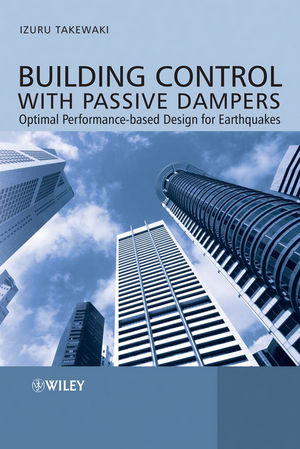Building Control with Passive Dampers: Optimal Performance-based Design for EarthquakesISBN: 978-0-470-82491-7
Hardcover
320 pages
October 2009
 This is a Print-on-Demand title. It will be printed specifically to fill your order. Please allow an additional 10-15 days delivery time. The book is not returnable.
|
||||||
1 Introduction.
1.1 Background and Review.
1.2 Fundamentals of Passive-damper Installation.
1.3 Organization of This Book.
References.
2 Optimality Criteria-based Design: Single Criterion in Terms of Transfer Function.
2.1 Introduction.
2.2 Incremental Inverse Problem: Simple Example.
2.3 Incremental Inverse Problem: General Formulation.
2.4 Numerical Examples I.
2.5 Optimality Criteria-based Design of Dampers: Simple Example.
2.6 Optimality Criteria-based Design of Dampers: General Formulation.
2.7 Numerical Examples II.
2.8 Comparison with Other Methods.
2.9 Summary.
Appendix 2.A.
References.
3 Optimality Criteria-based Design: Multiple Criteria in Terms of Seismic Responses.
3.1 Introduction.
3.2 Illustrative Example.
3.3 General Problem.
3.4 Optimality Criteria.
3.5 Solution Algorithm.
3.6 Numerical Examples.
3.7 Summary.
References.
4 Optimal Sensitivity-based Design of Dampers in Moment-resisting Frames.
4.1 Introduction.
4.2 Viscous-type Modeling of Damper Systems.
4.3 Problem of Optimal Damper Placement and Optimality Criteria (Viscous-type Modeling).
4.4 Solution Algorithm (Viscous-type Modeling).
4.5 Numerical Examples I (Viscous-type Modeling).
4.6 Maxwell-type Modeling of Damper Systems.
4.7 Problem of Optimal Damper Placement and Optimality Criteria (Maxwell-type Modeling).
4.8 Solution Algorithm (Maxwell-type Modeling).
4.9 Numerical Examples II (Maxwell-type Modeling).
4.10 Nonmonotonic Sensitivity Case.
4.11 Summary.
Appendix 4.A.
References.
5 Optimal Sensitivity-based Design of Dampers in Three-dimensional Buildings.
5.1 Introduction.
5.2 Problem of Optimal Damper Placement.
5.3 Optimality Criteria and Solution Algorithm.
5.4 Nonmonotonic Path with Respect to Damper Level.
5.5 Numerical Examples.
5.6 Summary.
References.
6 Optimal Sensitivity-based Design of Dampers in Shear Buildings on Surface Ground under Earthquake Loading.
6.1 Introduction.
6.2 Building and Ground Model.
6.3 Seismic Response.
6.4 Problem of Optimal Damper Placement and Optimality Criteria.
6.5 Solution Algorithm.
6.6 Numerical Examples.
6.7 Summary.
Appendix 6.A.
Appendix 6.B.
References.
7 Optimal Sensitivity-based Design of Dampers in Bending-shear Buildings on Surface Ground under Earthquake Loading.
7.1 Introduction.
7.2 Building and Ground Model.
7.3 Equations of Motion in Ground.
7.4 Equations of Motion in Building and Seismic Response.
7.5 Problem of Optimal Damper Placement and Optimality Criteria.
7.6 Solution Algorithm.
7.7 Numerical Examples.
7.8 Summary.
Appendix 7.A.
Appendix 7.B.
References.
8 Optimal Sensitivity-based Design of Dampers in Shear Buildings with TMDs on Surface Ground under Earthquake Loading.
8.1 Introduction.
8.2 Building with a TMD and Ground Model.
8.3 Equations of Motion and Seismic Response.
8.4 Problem of Optimal Damper Placement and Optimality Criteria.
8.5 Solution Algorithm.
8.6 Numerical Examples.
8.7 Whole Model and Decomposed Model.
8.8 Summary.
Appendix 8.A.
Appendix 8.B.
Appendix 8.C.
References.
9 Design of Dampers in Shear Buildings with Uncertainties.
9.1 Introduction.
9.2 Equations of Motion and Mean-square Response.
9.3 Critical Excitation.
9.4 Conservativeness of Bounds (Recorded Ground Motions).
9.5 Design of Dampers in Shear Buildings under Uncertain Ground Motions.
9.6 Numerical Examples I.
9.7 Approach Based on Info-gap Uncertainty Analysis.
9.8 Evaluation of Robustness of Shear Buildings with Uncertain Damper. Properties under Uncertain Ground Motions.
9.9 Numerical Examples II.
9.10 Summary.
Appendix 9.A.
Appendix 9.B.
References.
10 Theoretical Background of Effectiveness of Passive Control System.
10.1 Introduction.
10.2 Earthquake Input Energy to SDOF Model.
10.3 Constant Earthquake Input Energy Criterion in Time Domain.
10.4 Constant Earthquake Input Energy Criterion to MDOF Model in Frequency Domain.
10.5 Earthquake Input Energy as Sum of Input Energies to Subassemblages.
10.6 Effectiveness of Passive Dampers in Terms of Earthquake Input Energy.
10.7 Advantageous Feature of Frequency-domain Method.
10.8 Numerical Examples for Tall Buildings with Supplemental Viscous Dampers and Base-isolated Tall Buildings.
10.9 Summary.
References.
11 Inelastic Dynamic Critical Response of Building Structures with Passive Dampers.
11.1 Introduction.
11.2 Input Ground Motion.
11.3 Structural Model.
11.4 Response Properties of Buildings with Hysteretic or Viscous Dampers.
11.5 Upper Bound of Total Input Energy to Passively Controlled Inelastic. Structures Subjected to Resonant Sinusoidal Motion.
11.6 Relationship of Maximum Interstory Drift of Uncontrolled Structures with Maximum Velocity of Ground Motion.
11.7 Relationship of Total Input Energy to Uncontrolled Structures with Velocity Power of Ground Motion.
11.8 Summary.
Appendix 11.A.
Appendix 11.B.
Appendix 11.C.
References.
Index.



